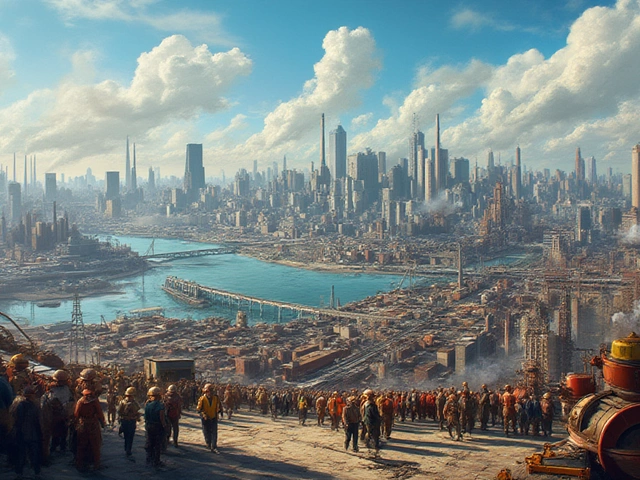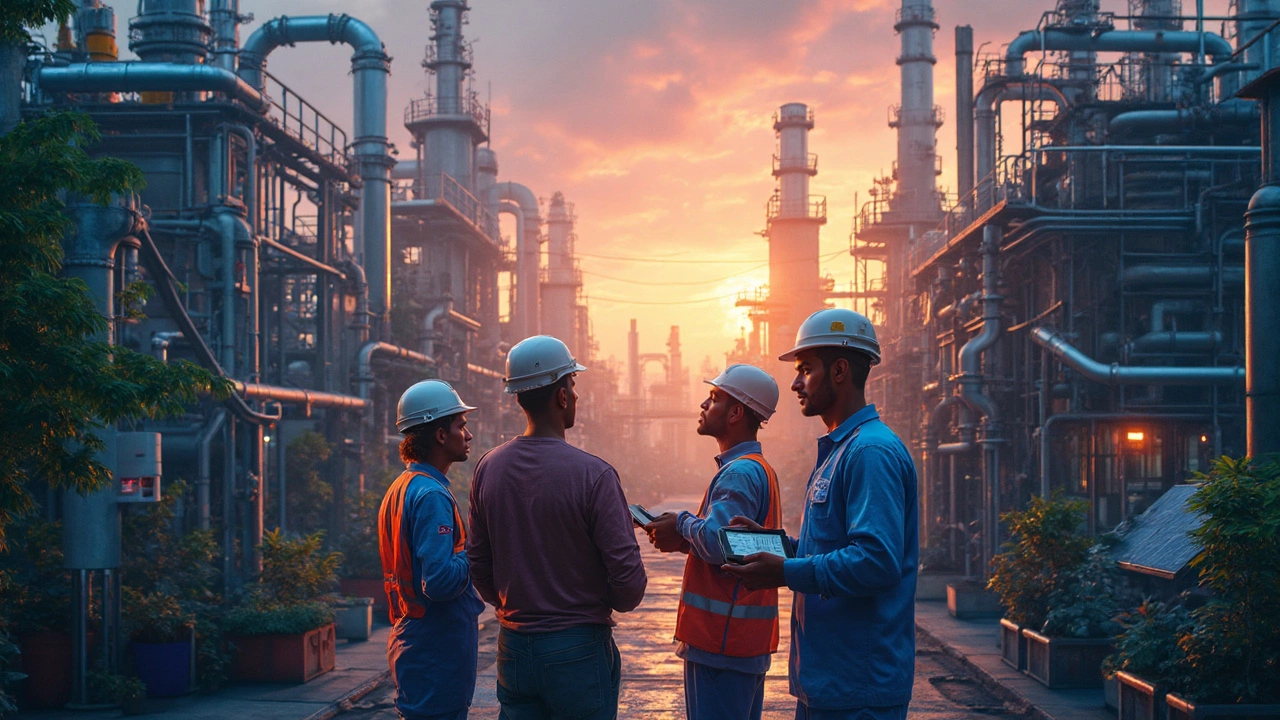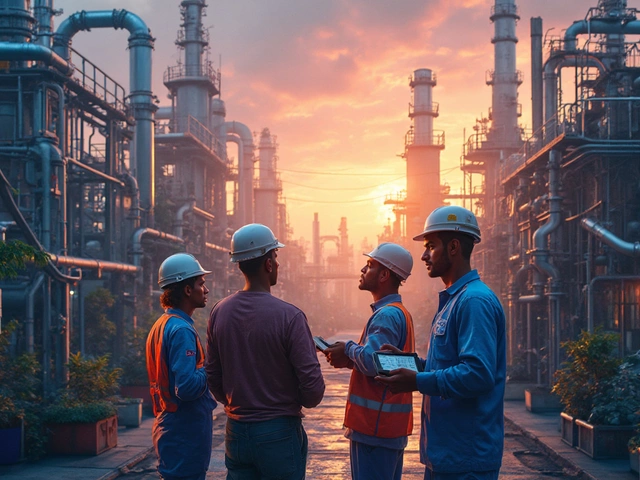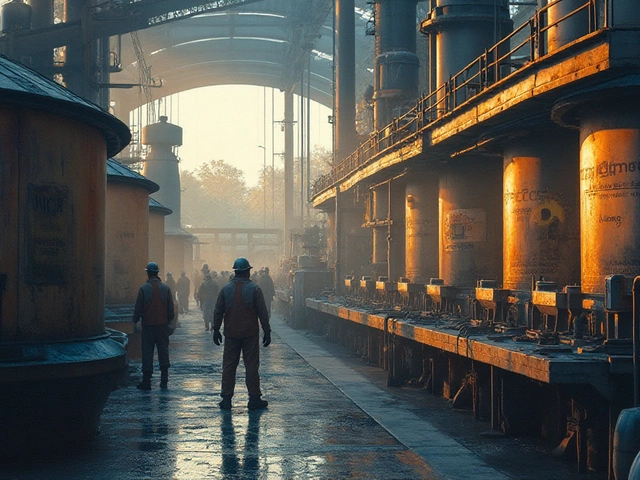Ask anybody in the business world—India’s chemical industry is a serious heavyweight these days. Forget the old-school, dusty image. This sector now sits among the top six in the world by production size, and it’s not slowing down. Urbanization, rising incomes, and the massive growth of everything from agriculture to pharma have chemicals doing all the heavy lifting behind the scenes.
What’s the secret sauce? For starters, India’s got a huge domestic market plus a growing edge in exports, especially as global buyers look to diversify away from China. In FY24, the country shipped out well over $30 billion worth of chemicals. Not shabby, right?
But it’s not just about big numbers. If you’re in the industry—whether running a factory or working the supply chain—the thing to watch right now is the shift toward specialty chemicals and eco-friendly alternatives. That’s where the money, and future jobs, are heading. Automation and smart digital systems are also taking over routine tasks, trimming costs, and catching errors before they turn into expensive disasters.
- Why India’s Chemical Industry is Booming
- Big Challenges on the Road Ahead
- Green Chemistry: Hype or Game Changer?
- How Digital Tools Are Shaking Things Up
- What Global Competition Means for India
- How to Get Ahead: Tips for Indian Chemical Makers
Why India’s Chemical Industry is Booming
Take a look around—everything from paint on your walls to the pills in your cabinet probably has a link to India’s chemical sector. This industry is firing on all cylinders for a bunch of real-world reasons.
First up, India’s home market is enormous. With over 1.4 billion people and a growing middle class, the demand for everything—fertilizers, plastics, textiles, and medicines—is exploding. Farmers depend heavily on chemicals for higher yields, and as manufacturing ramps up, so does the need for raw materials.
Government policies have given the industry a boost. Schemes like the Production Linked Incentive (PLI) and Make in India are turning the spotlight on chemical manufacturers. There are special chemical zones and infrastructure upgrades popping up in Gujarat, Maharashtra, and Tamil Nadu, making it cheaper and quicker to move goods out.
Here’s the thing: global buyers are shopping for alternatives beyond China. India stepped up, especially during pandemic supply shocks, snagging deals to supply dyes, pigments, and specialty chemicals for Europe and the US. In fact, specialty chemicals exports jumped by almost 20% in 2023, according to industry reports.
| Fact | Number |
|---|---|
| Industry Value (2024) | $220 billion |
| Industry Growth Rate (Annual) | 8-9% |
| Global Ranking (Production Volume) | 6th |
| Specialty Chemical Exports Growth (2023) | ~20% |
Cost is another big win for India. Labor is affordable, factories are getting more tech-savvy, and local companies are scaling fast. They now handle everything from simple bulk chemicals to high-margin specialty products used in drugs, food processing, and electronics.
If you’re eyeing the future, keep an eye on that sweet spot—balancing cost, quality, and innovation. That’s how chemical industry India is catching eyes both at home and overseas.
Big Challenges on the Road Ahead
The chemical industry in India, even with its momentum, hits some real speed bumps. Let’s tackle the most glaring ones that everybody’s talking about in boardrooms and factory floors.
First up, handling the scale of strict environmental rules is a daily headache. Indian lawmakers have tightened standards, and states like Gujarat and Maharashtra have seen dozens of chemical units get shut down for pollution. Even small slip-ups can mean costly fines or forced shutdowns. Keeping up with all the paperwork and safety drills eats into time and budgets, especially for smaller players.
Raw material prices aren’t helping either. India imports over 40% of its critical chemicals—from solvents to specialty feedstocks—and wild swings in global prices hit profit margins hard. Add shipping delays or a surprise export ban from China, and entire supply chains get thrown off. No surprise that chemical manufacturers are hunting for local suppliers, but building that kind of ecosystem takes years.
When it comes to skilled workers, there’s a talent crunch. Many factories run into trouble finding technicians who are trained for modern, safer processes. Most chemical plants still struggle with old machinery, which can cause both inefficiencies and safety risks. Modernizing these setups isn’t just expensive—it means downtime and a steep learning curve for the team.
Competition is another beast. Global giants can offer lower prices or superior technology, while local regulations sometimes make it tricky for Indian firms to expand overseas. The real pros are already pushing the envelope on R&D to keep up.
- Environmental compliance costs are rising faster than before.
- Supply chain interruptions are now more common.
- Workforce upskilling and safety training need an upgrade.
- Access to steady, affordable power is still patchy in some hotspots.
Despite the hype, the chemical industry India faces a tough road ahead. The ones that survive will be those that adapt quickly, manage risks, and never get too comfortable with the way things were done before.
Green Chemistry: Hype or Game Changer?
Green chemistry isn’t just the latest buzzword—it’s a total rethink of how chemical manufacturers in India make the products we use every day. Thanks to tighter environmental rules and customers who actually care what goes into their food, medicine, and packaging, green chemistry is getting some serious attention. Investors are also on board. Tata Chemicals and Aarti Industries have funneled money into bio-based and waste-minimization technologies, not just to look good, but because the numbers make sense.
So, what does green chemistry mean on the ground? Basically, it’s about using fewer toxic ingredients, creating less waste, saving energy, and recycling more. The end result: safer workplaces and cleaner air and water. Some Indian companies are replacing old-school solvents (think nasty stuff that nobody wants around) with alternatives based on plant extracts or enzymes. A leading agrochemical maker out of Gujarat switched key steps in its production to water-based processes, slashing chemical waste by half.
Another driver is global competition. Europe’s REACH standards and the U.S. focus on sustainability make it almost impossible to export old, polluting chemicals now. To keep exports rolling, Indian companies have no choice but to step up and meet these benchmarks.
Green chemistry also isn’t just for the big players. Large and small manufacturers are tapping into government grants from India’s Department of Chemicals & Petrochemicals, which supports R&D into cleaner production. If you’re looking for tips to ride this wave, start with these basics:
- Switch to renewable feedstocks wherever possible.
- Invest in cleaner production tech—even small changes add up fast.
- Train your team. New tech means new skills, and safety comes first.
- Keep records. Tracking your waste and emissions helps spot quick wins for savings.
Is green chemistry a game changer? Absolutely. It’s not just good for the planet—it’s quickly becoming the price of entry for anyone who wants to call themselves a top chemical industry India player.

How Digital Tools Are Shaking Things Up
The truth is, Indian chemical manufacturers aren’t stuck in the past. Digital transformation is messy, sure, but it’s changing everything from how warehouses work to how products hit the market. With real-time supply chain tracking, automated quality checks, and digital twins for plants, companies are finally shedding paper-based systems.
Here’s where things get interesting. SAP and similar ERP platforms are now basic tools for midsize and up manufacturers. These platforms help track tons of data—production, inventories, sales, even machine downtime—making decisions much quicker. And with sensors and IIoT (Industrial Internet of Things), factories can catch problems before something breaks. For example, Grasim Industries reported in 2024 that sensor-based monitoring cut their equipment downtime by 22% in less than a year.
AI is cropping up too, mostly in quality assurance and logistics. Picture this: Instead of routine human checks, machine learning can spot off-spec batches way faster and flag them instantly. Advanced analytics are helping with demand forecasting, so companies avoid those painful overstock or shortage situations—something that’s a big deal given the volatility in chemical prices lately.
Check out this quick table to see some ways Indian chemical businesses are putting digital tools to work:
| Digital Tool | Main Benefit | Example in Use |
|---|---|---|
| ERP Systems | Centralizes operations | Pidilite uses ERP to manage supply chain and production flows |
| Sensors/IIoT | Reduces downtime, improves safety | Grasim cut downtime by 22% using equipment sensors |
| AI-based QA | Faster defect detection | Machine learning to flag off-spec product batches |
| Digital Twins | Simulates plant processes | Reliance runs digital simulations for process optimization |
There are even pilot projects for blockchain-based tracking, letting buyers verify a chemical’s whole journey. That’s especially big for exports, where paperwork and delays still eat up weeks. By the way, some plants in Gujarat are using remote monitoring that lets managers check in on operations from their phones, day or night.
If you’re still managing things the old way, the writing’s on the wall: digital tools aren’t just for the big guys anymore. Smaller players can tap into cloud solutions and mobile apps, paying only for what they need. That means more agility and the chance to compete with much larger companies in the chemical industry India space.
What Global Competition Means for India
If you think Indian chemical manufacturers can just sit back and rake in profits, think again. The global game is getting tougher. China has long dominated the scene with dirt-cheap prices and tight supply chains, but there’s been a twist: companies worldwide want alternatives to putting all their eggs in one basket. India’s stepped up as a top pick, but it comes with no free passes.
Here's the deal: India now exports specialty chemicals to over 175 countries. Its main buyers? The US, China, Brazil, and the European Union. While that sounds impressive, the race is tight. Local producers in these regions aren’t taking things lying down. For example, Europe’s strict green rules can block shipments if Indian products don’t meet those standards. Meanwhile, China keeps slashing prices to hold onto its market share.
| Country | Share of India's Chemical Exports (2024) | Growth Rate YoY (%) |
|---|---|---|
| United States | 19% | 12.5 |
| China | 13% | 9.8 |
| Brazil | 7% | 14.3 |
| European Union | 22% | 7.1 |
Costs are another crunch point. Big global players run hyper-efficient operations. To keep up, Indian chemical companies are betting on things like better logistics, smarter energy use, and tighter process controls. A bunch of manufacturers are teaming up with global giants, entering joint ventures, or buying up smaller outfits abroad, just to keep pace—or get a step ahead.
But it’s not just about money and machines. Reputation counts, too. International buyers want proof—certifications, safety track records, quick response times. If a batch is late or quality slips, someone overseas will be happy to pick up that order.
- If you’re a new player, speed up getting international quality certifications—think ISO, REACH, and others.
- Watch global trends closely. Demand for eco-friendly chemicals is skyrocketing, especially in Europe and North America.
- Don’t ignore branding and after-sales support. Companies that win abroad often succeed on service, not just price.
The big takeaway? Chemical industry India is in the spotlight, but the world isn’t waiting around for anyone. Staying competitive means constant upgrades, sharp market knowledge, and building trust—one container at a time.
How to Get Ahead: Tips for Indian Chemical Makers
If you want your company to stand out in the chemical industry India scene, just pumping out massive volumes isn’t enough anymore. It’s all about moving smart, not just moving fast.
Here’s what leading companies and experts are focusing on right now:
- Invest in R&D: There’s no shortcut here. According to a 2023 report by McKinsey, Indian chemical firms that spend at least 2% of their revenue on research and development are three times more likely to develop products that hit global quality standards.
- Go green, get ahead: The export game is changing. European partners are demanding low-carbon, eco-friendly chemicals. Caring about your emissions and handling hazardous waste well isn’t just nice anymore—it’s basic survival if you want to sell abroad.
- Upgrade your tech: You don’t need robots in every corner, but even simple digital dashboards or ERP software can make a noticeable dent in costs and help avoid surprise shortages or shutdowns.
- Train your people: India’s chemical workforce is massive, but just having people isn’t enough. Skills in automation, process safety, and compliance are what separate the winners. Some big manufacturers even run in-house short-term learning programs every quarter now.
- Make partnerships: Tie-ups with global firms or Indian startups can open doors in foreign markets, bring in new ideas, or even make regulatory headaches less painful.
Sound like a lot? It kind of is, but here’s the payoff: According to the Indian Chemical Council, companies that steadily invest in tech, compliance, and people are 60% more likely to boost exports over a five-year period.
“The next decade will belong to chemical companies that embrace sustainability, digitization, and talent upskilling. Those who don’t will find themselves left behind,” says Dr. Ram Menon, Director at FICCI Chemicals Division.
If you’re already making moves in these areas, keep pushing. If you’re not, now is the time. The market’s growing too fast to sit on your hands.






Write a comment